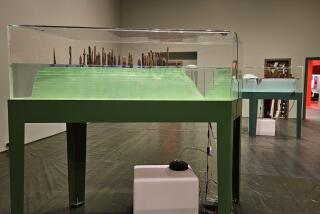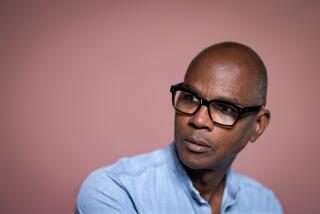Reviving the French contemporary art scene
PARIS —When Théo Mercier talks about his work — sculptures with tribal masks sticking out their tongues or flora sprouting around fleshy pink, bulbous posteriors — he does it with a straight face. His sculpture, “The Loner,” is “a kind of monster monument,” he said, then paused. “In spaghetti.”
The 27-year-old’s sculptures can be disturbingly funny but beautiful creatures to look at. “We never know … if we are dealing with something amusing, or something sad,” he said of his creations. They include human body parts dressed in street wear, latched onto indigenous artifacts, with intricately arranged fruits and seashells, that all transform into beings fit for some crazed Neverland.
Dubbed a “Dada of the 2010’s” by the French Beaux Arts magazine, Mercier often makes his more life-like “monstrosities,” as he calls them, dance or just slump with a silly grin. And the French public is grinning right back, especially since he exhibited his nearly 10-foot-high spaghetti man in a group show at Paris’ Museum of Modern Art in 2010.
All of which might seem odd because Mercier doesn’t make the kind of art usually associated with the French scene. He doesn’t explicitly attempt to deconstruct grand theories with his work, which also includes photographs. When it comes to philosophy, he said he “would rather read about it” than see an exhibit by a conceptual artist. His sculptures don’t evoke the clichés of postmodern French art, often called “intellectualisant,” as one critic said. By that he meant “boring.”
Mercier is also a testament to the diverse range of French contemporary art, which has tended to be overlooked outside France. Since Paris lost its status as the global center for the arts decades ago, the contemporary art scene here has suffered in varying degrees, with studies showing French artists are left out of major public and private collections abroad.
“For a time you could get a lot of kudos for being a British, American artist or a German artist,” said Jennifer Flay, the director of the International Contemporary Art Fair, or FIAC, in Paris. “But for some reason being a French artist was kind of a minus.”
And though “there is still something of that left,” Flay said, she, like many others here, believes the situation “has changed for the better.” The younger generation doesn’t seem to have had to overcome “the same huge obstacles as a whole generation of French artists that are excellent but were largely ignored for most of their careers.” Younger artists like Tatiana Trouvé, Cyprien Gaillard and Adel Abdessemed, for example, have enjoyed growing recognition abroad.
“There are fantastic French artists out there,” said Allegra Pesenti, curator of the Hammer Museum’s Grunwald Center for the Graphic Arts. For Pesenti, the only problem has been finding them. “The thing that’s always surprised me is that there are great galleries in Paris, and yet they show so few French artists,” she said, noting that Gaillard is participating in a residency at the Hammer.
Even the Hammer’s current exhibition by late Polish sculptor Alina Szapocznikow, who lived many years in Paris, is an example of “one of these fantastic talents completely overlooked by the French” during her life and decades after her death in the 1970s, Pesenti added.
Mercier, at the start of his career, hasn’t been significantly shown outside France and Germany. He nevertheless won international attention at the October 2011 FIAC, which has been successfully wooing major galleries and collectors back in recent years.
Many here hope that trend is part of a general “dusting off of the Paris” contemporary art scene and a sign of shifts in France’s art world. They credit FIAC’s growing international appeal with strengthening the local art market, as collectors here take a more active interest and waves of new French exhibit spaces have emerged alongside heavily promoted prizes for young artists, who are themselves leading increasingly nomadic, international careers.
Pesenti said she is impressed by the wide range of exhibitions in Paris and experienced a “special buzz” on recent visits. “There were lots of openings in the same week, so lots of people meeting and interacting and exchanging of ideas,” she said. Her only caveat is that, “these are not visits that introduce me to Parisian and French artists, but they introduce me to a great scene.”
In a catalog for a fall 2011 exhibition dedicated to France’s art scene, professor Pia Muller-Tamm, head of the Staatliche Kunsthalle Karlsruhe museum in Germany, wrote that Paris “has unmistakably showed itself to be a center of contemporary art.”
But to others, there is still doubt that much has changed since a state-funded system held the reigns over which artists were promoted abroad and tended to scoff at the importance of the international art market. For years, state institutions “had a tendency to prefer more intellectual artwork based on concepts, and this was done in detriment to other types of works,” notably painting, said Nathalie Heinich, art sociologist for the National Research Center for the Sciences in Paris.
Although many say those days of stronger public support are past, sociologist Alain Quemin disagrees. “In France, there is suspicion of the [art] market,” which is considered too closely associated with commercial art, he said. A sociology of art professor at the University of Paris-VIII, Quemin says the importance of French artists abroad has essentially stayed the same over the last decade.”They have practically disappeared from the major international museums like MOMA or Tate Modern.”
According to Quemin, the last widely recognized French artist both in terms of market price and presence in major collections was Yves Klein, who died in 1962.
However, Quemin recognizes some positive changes, such as the FIAC’s rebound, and the creation of private institutions like the Maison Rouge Foundation by Antoine de Galbert, as a balance to the state-sponsored system. Others highlight the influence of the Palais de Tokyo contemporary art center. Created in 2002 to promote experimental and emerging artists in France and abroad, the Palais de Tokyo reopened last week with almost 50,000 square feet of extended space.
Additional private support for the arts is often seen as an opportunity for breaking with the institutional old guard — without doing away with public funding for culture. “This space doesn’t depend on anyone — not on public money,” said Galbert of the Maison Rouge. “It’s a space of total freedom … where a person can dare to do what he wants.”
Years of relative international neglect for French art means more unknown talent for some traveling art lovers to discover.
German collector Thomas Olbricht said he only recently learned about contemporary French art, thanks to a collection exchange with Galbert. “It’s interesting because I went to China, Turkey, India to look for art, but not to France,” said Olbricht, who used to come to Paris for art history. “Now I have learned that I also have to look for French contemporary art.”
In his apartment in northern Paris, decorated with birds of paradise in large vases, a low-hanging jungle of vines forcing visitors to duck through the main hallway, and a front door framed with vintage stuffed animals and insects pinned to the wall, Mercier noted he didn’t follow a typical French career in the arts, choosing the Parisian industrial design school for his studies.
He switched focus after a student gig assisting artist Matthew Barney in New York. If it hadn’t been for that, Mercier would probably be designing rather fabulous car doors, he said. With Barney, Mercier said, “I discovered that ambition in man wasn’t necessarily something disgusting, linked to power and money, but that ambition could simply be a magnificent energy, the energy of an artist, in fact, to create. To make.”
More to Read
The biggest entertainment stories
Get our big stories about Hollywood, film, television, music, arts, culture and more right in your inbox as soon as they publish.
You may occasionally receive promotional content from the Los Angeles Times.






